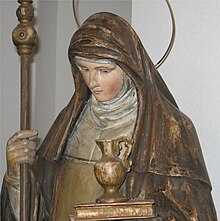Saint Walburga
Saint Walpurga or Walburga (Old English: Wealdburg; c. 710 – February 25, 777 or 779), also spelled Valderburg or Guibor,[1] was an English missionary to the Frankish Empire. She was canonized (confirmed as a saint) on 1 May ca. 870 by Pope Adrian II.

Walpurga's feast day is on 25 February. The day of her canonization, 1 May, was also celebrated during the high medieval period. Especially in the 11th century under Anno II, Archbishop of Cologne. Walpurgis Night is the eve of May Day, celebrated in folklore in Europe with dancing.
Life
changeTogether with her brothers, Saint Willibald and Saint Winibald, she travelled to Francia (now Württemberg and Franconia) to help her uncle, Saint Boniface, in evangelizing among the Germans. She was educated by the nuns of Winborne Abbey, Dorset, where she spent twenty-six years. Thanks to her rigorous training, she was later able to write St. Winibald's biography and an account in Latin of St. Willibald's travels in Palestine. She is often credited with being the first female author of both England and Germany.[2]
She became a nun and lived in the double monastery of Heidenheim am Hahnenkamm near Eichstätt, which was founded by her brother, Willibald. After his death in 751, she became abbess. Walburga died on 25 February 777 or 779 and was buried at Heidenheim. In the 870s, her remains were brought to Eichstätt.
At Eichstätt, her bones were placed in a rocky hole in the wall. The bones began to produce, it was said, a miraculously therapeutic oil. This made people come to her shrine.
The earliest picture of Walpurga is from the early 11th century. It comes from the Hitda Codex, which was made in Cologne. It shows her holding stylized stalks of grain. The grain can be seen as an example of where a Christian saint (Walpurga) took over from an older pagan concept, in this case of the Grain Mother.[3]
Walpurga is the patroness of Eichstätt, Antwerp, Oudenaarde, Veurne, Groningen, Zutphen and other towns in the Low Countries.[4]
References
change- ↑ Other spellings: Valborg (the Swedish name for her), Walburge, Valpuri, Auboué, Avangour, Avongourg, Falbourg, Gaubourg, Gualbourg, Valburg, Valpurge, Vaubouer, Vaubourg, Walbourg, Walpurd, Warpurg. She is also known by the seemingly unrelated names Perche and Eucharis.
- ↑ A point made by St. Walburga's entry at the Catholic Encyclopedia
- ↑ Pamela Berger, The Goddess Obscured: Transformation of the Grain Protectress from Goddess to Saint, 1985:61-64, gives several examples and bibliographical notes.
- ↑ Catholic Encyclopedia gives a fuller list.